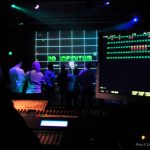
| Submitted: Mercer Aplin | Position:Clinical Assistant Professor – Audio Technology | Date: October 9, 2025 |
If you represent this school, and the information below is incorrect, please email info@tsdca.org. If you want to know who TSDCA is a graduate of this program, you can search the member directory.
- School Location
West Lafayette, Indiana
- Description of your program:
Purdue’s Theatre MFA Sound Design and Audio Technology Plans of Study are intended to prepare students for fulfilling careers in professional or educational theatre and the entertainment industry.
Emphasis is placed on the development of technical training and skills that will serve students in the practice of their craft through a long and varied career. This is accomplished through a balanced training program of classes, work on realized productions, and individualized tutorials.
Skills training is an important component of the Purdue program. Coursework is intended to provide a solid basis for the student’s professional work in the theatre or a related fields.
- What makes your program unique:
Purdue’s is the oldest graduate sound design program in the country (established in 1975), perhaps the world. We are a very small program, and our placement has consistently shown this to be our great strength.
Purdue typically offers assistantships to theatre graduate students which covers nearly all of tuition costs and provides a salary to graduate students for teaching sound courses within the department or working with Purdue’s in-house production company (Hall of Music Productions) which provides production support to touring shows, athletic events, concerts, and other campus functions.
The two faculty mentors for the program continue to work outside of their roles at Purdue in the sound design and AV system design industries.
- Current Faculty Names & links to Websites:
Fan Zhang – Assistant Professor of Sound Design – fanzhangsound.com
Mercer Aplin – Clinical Assistant Professor of Audio Technology – sound-power.com
https://cla.purdue.edu/academic/rueffschool/theatre-and-dance/
- Type of degree conferred
MFA in Theatre with plans of study in Sound Design or Audio Technology
- Number of years of study
Three
- Approximately how many students graduate from the Sound program each year?
One per year
- Description of the venues and facilities the students have access to in our program.
During residency, the graduate sound student designs a variety of systems in a variety of spaces, ranging from flexible Black Box, to thrust, proscenium, and Union houses.
Audio Systems in the Hansen Theatre, Mallett Theatre, and Audio Production Studio have been recently upgraded to give students hands-on experience with industry standard equipment. Major systems elements include:
- Hansen Theatre:
- New Yamaha QL5 Digital Mixing Console with Rio 1608 Stage Boxes
- New Q-Sys Processing and Amplification (40 Channels of Amplification)
- New Renkus Heinz Loudspeaker System
- New Shure wireless microphone systems
- Mallett Theatre:
- New Yamaha QL1 Digital Mixing Console with Rio 1608 Stage Boxes
- New Q-Sys Processing and Amplification (24 Channels of Amplification).
- New Renkus Heinz Loudspeaker System
- Audio Production Studio:
- New Yamaha DM7 Digital Mixing Console
- New Aviom Headphone Monitoring System
- New Dynaudio Acoustics Studio Monitors (7.1 surround configuration)
- Pao Hall Dance Studio:
- New Allen & Heath SQ Rack Mixers
- New d&b audiotechnik loudspeaker systems.
- Fusion Studio for Entertainment and Engineering – John Martinson 4D Experience Lab:
- New d&b audiotechnik 12.1 loudspeaker system
- Integration with lighting and show control systems
- Description of the production and design opportunities a typical student can expect:
Projects range from class exercises to one-acts, student-directed projects, dance, mainstage productions, and touring productions, with a special emphasis on Broadway-style musicals.
Each subsequent project has a greater support system of technical assistance and an increasing budget.
Each MFA student is required to produce minimum of one realized project is required each semester. The culmination of the program is typically an extensive Musical or dramatic work requiring significant musical composition which forms the basis for the Terminal Project or Thesis Paper, although other projects can be designed to specifically target the student’s career path.
- Skills and characteristics looked for when admitting a student to your program:
A limited number of students are selected each year on the basis of resumes, interviews, and portfolio reviews. A visit to Purdue is recommended, to allow the potential student to interact with students and the faculty. Applicants must have sufficient experience to teach beginning courses in theatre sound design and technology or audio production or large venue sound reinforcement.
- Skills and characteristics of a successful graduate:
Skills training is an important component of the Purdue program. Coursework is intended to provide a solid basis for the student’s professional work in the theatre or a related field.
Upon completion of graduate study, the student should have the ability to design/compose music and sound effects for theatrical productions, install, verify and calibrate sophisticated sound systems; they should be fully able to serve as the Sound Designer, Assistant Sound Designer, Head Sound Engineer, Production Sound Engineer or Assistant Sound Engineer on any production at any professional level. They should develop exceptional abilities to work collaboratively as part of a performing arts team.
- Where should a prospective student go for further Information?
For specific questions regarding the Theatre MFA Sound Design/Audio Technology plans of study, contact:
Assistant Professor, Sound Design: Fan Zhang – zhan4748@purdue.edu
Assistant Professor, Audio Technology: Mercer Aplin – maplin@purdue.edu
For general information about the Department of Theatre, contact:
Theatre Operations Manager and Graduate Secretary: Beth Daugherty – bbessler@purdue.edu
